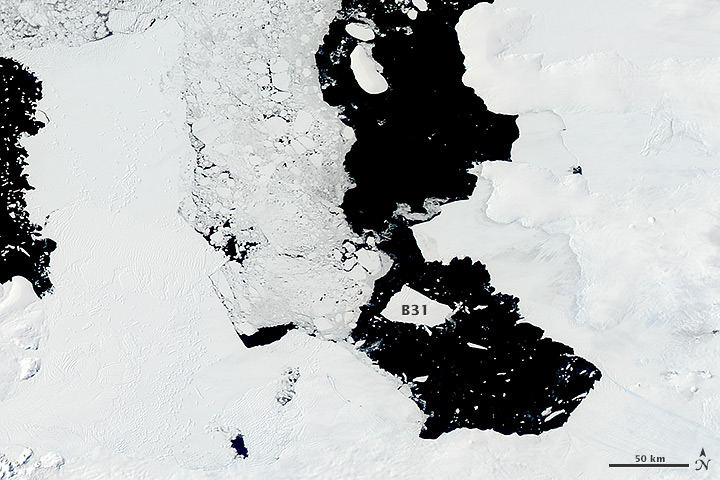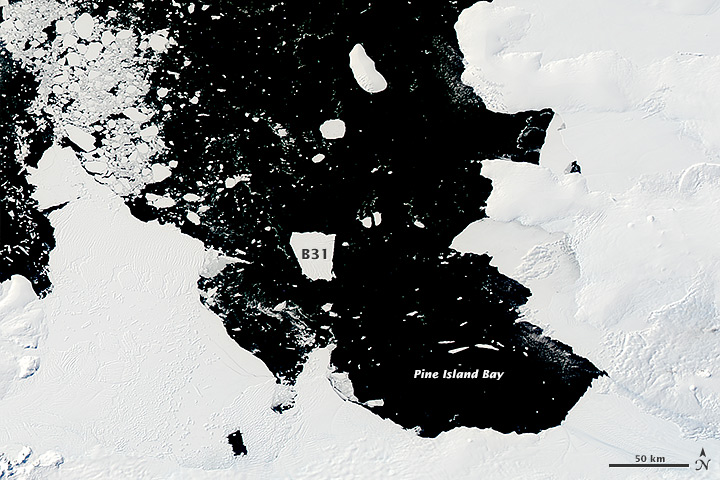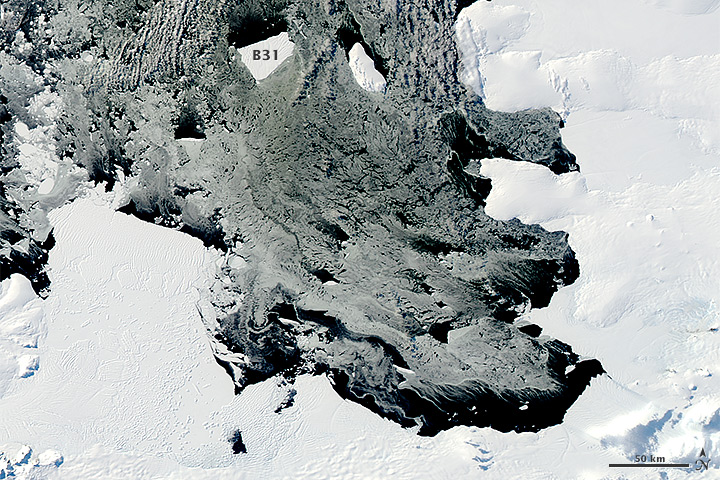
Iceberg B-31 acquired by the Operational Land Imager on the Landsat 8 satellite November 13, 2013.
Image Credit NASA
Knowledgeorb.com reported last November when Iceberg B31 broke off. This iceberg is as big as a city and is now could the enter shipping lanes. The iceberg is 33 kilometers long and 20 kilometers wide (18 by 11 nautical miles) and may be as thick as 500 meters.
The time-lapse video below shows the motion of the massive chunk of ice.
The significance of the event is still being sorted out. “Iceberg calving is a very normal process,” noted Kelly Brunt, a glaciologist at NASA’s Goddard Space Flight Center. “However, the detachment rift, or crack, that created this iceberg was well upstream of the 30-year average calving front of Pine Island Glacier (PIG), so this a region that warrants monitoring.”
PIG has been the subject of intense study in the past two decades because it has been thinning and draining rapidly and may be one of the largest contributors to sea level rise. But ice islands and icebergs are not only tracked for scientific purposes; maritime agencies follow them because of the danger they can pose to ships.
A research team led by Grant Bigg of the University of Sheffield has been tracking the ice island with synthetic aperture radar and visible satellite imagery, while also modeling the drift of the ice.
“It has been very interesting how little sea ice there has been in the area,” Bigg said. “In the video, you can certainly see clouds suggesting strong katabatic wind flow off the glacier in the first month or two, which would have kept the Bay ice-free and helped guide the iceberg out.”
“B31 has been well-tracked,” said David Jones of the British Antarctic Survey (BAS). In January 2013, a few months after a rift was detected in the ice shelf of Pine Island Glacier, Jones and colleagues flew over the region and dropped 37 javelin-shaped Aircraft Deployable Ice Observation Systems (ADIOS) onto the ice. ADIOS is basically a GPS tracker, and it is helping researchers monitor the glacier’s movements. Two of the ADIOS javelins were dropped on top of B31 before it broke off from the continent. “Thanks to the early detection of its calving by the IceBridge program, we have been able to study its dynamics from early on in its lifecycle.”
“We are doing some research on local ocean currents to try to explain the motion properly. It has been surprising how there have been periods of almost no motion, interspersed with rapid flow,” Bigg added. “There were a couple of occasions early on when there might have been partial grounding or collisions with the seafloor, as B31 bounced from one side of the Bay to the other.”
“While some mass was lost very early on in the life of B-31, it has remained pretty much the same shape since early December and is still about six times the size of Manhattan,”
NIC last observed B31 at 72° 23′ South latitude, 108° 03′ West longitude. Bigg added that “the iceberg is now well out of Pine Island Bay and will soon join the more general flow in the Southern Ocean, which could be east or west in this region.”










